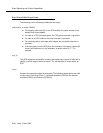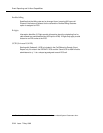
Event Reporting and U-Abort Capabilities
3-22 Issue 7 May 1998
■ For incoming DCS calls, if the DCS calling party information is available to
ECS (if a station with a display gets it), this information is also made
available to ASAI.
■ For incoming calls over R2-MFC facilities, if the calling party information is
provided, it is collected and passed onto the adjunct.
NOTE:
There is a special case of a switch-classified call being offered to a split. In this case,
the Calling Party number contains the original digits (from a switch-classified Third
Party Make Call Request) provided in the destination field.
trunk group number/trunk group member number
The Trunk Group number and Trunk Group Member number are only provided if
the Calling Party number is unavailable.
called party number (DNIS)
■ For incoming calls over PRI facilities, the Called Party Number as in the
ISDN SETUP message.
■ For incoming calls over PRI facilities to a VDN that does lookahead
interflow on calls, if the lookahead interflow attempt fails, the called number
provided is the principal extension of the dialed number.
■ For incoming calls over non-PRI facilities, the Called Party Number is the
principal extension [may be a group (TEG, PCOL, hunt group, VDN)
extension
8
].
■ The special case of a switch-classified call being offered to a split, noted
previously, contains the split extension as provided in the origination field of
the Third Party Make Call Request.
user-entered information
Contains up to 16 digits from the most recent Collect Digits vector step. Starting
with Release 5, the user-entered information may also include network-provided
digits (CINFO).
For more information regarding vectors, see the
DEFINITY Enterprise
Communications Server Administration and Features Description
, 555-230-522,
and the
DEFINITY Enterprise Communications Server Call Vectoring/Expert
Agent Selection (EAS) Guide
, 555-230-521.
8. If the ECS is administered to modify the DNIS digits, then the true DNIS is not passed


















